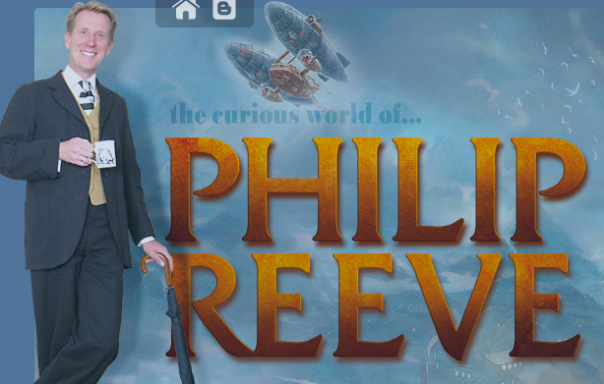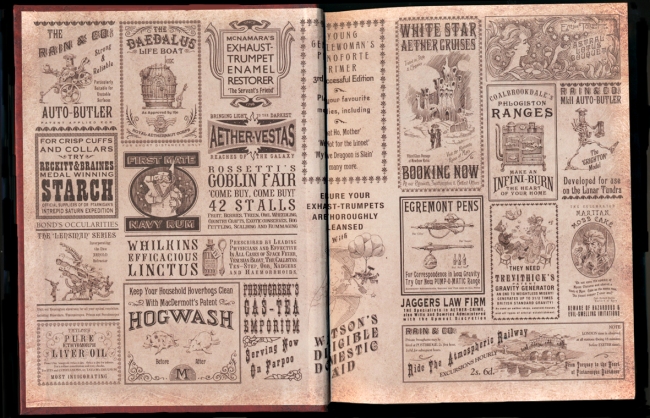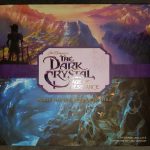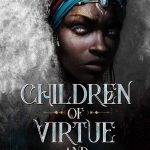Five Reasons Why Philip Reeve Should Be Your New Favourite Author

You probably haven’t heart of Philip Reeve. No, this isn’t the start of a hipster rant about some tiny author who only writes flash fiction on the side of Starbucks cups that I am so achingly cool I know about it and you don’t. This is a rant about how much I am in love with one man who looks like Mycroft Holmes’ chirpy alter-ego, and the absolutely travesty it is that there aren’t statues of him in public.
Ok, so lets start with the basics. Here is Philip Reeve:

So, as the impassioned fangirl that I am, I’ve decide to take it upon myself to persuade everyone I possibly can do go out, track down a copy of any of his books, read his blog, stalk his twitter. The power of internet fandom to revive, inspire, or downright coerce creative-work-du-jour to recognition is well documented. I present to you, the denizens of the internet, five reasons why Philip Reeve should be at the top of your To Read list.
1. The Hungry Cities (yes look I know what I said, just go with me on this one)
“Hungry Cities” (thankfully now being rebranded as “Predator Cities”) is a crude name for Reeve’s dystopian far distant future society, where traction cities crawl through the nuclear wasteland that was once Europe, practicing the grim philosophy of “Municipal Darwinism”. Reeve’s traction cities are the famous (and not so famous) European capitals mounted on wheels, caterpillar tracks, ski – whatever will keep these behemoths moving. Movement is live; the strong cities hunt the weak, capture and devour them in a stark but engrossing metaphor for pure, destructive capitalism. Survival of the fittest is taken ad ridiculum, resulting in cataclysmic destruction of the environment (not to mention the moral standing of London’s population and government). Ranged against the traction cities is the Anti-Traction League, a fundamentalist grouping of anti-technology states sworn to bring down Municipal Darwinism at any cost.
So far so good, right? Glorious steampunkery in an extravaganza of witty world-building and and pop-culture references deep enough to eat with a spoon. But under that lies Reeve’s true genius Reeve never gives us White Hats to root for, or Black Hats to despise. He won’t make it that easy for us. Neither Municipal Darwinism or the Anti-Traction League offer a workable vision of society. Good and evil are found in both. Sometimes the good guy is so good that he can’t bring himself to fight. Sometimes the bad girl who does all the wrong things, is the only one brave enough to take up the sword.
Which brings me to…
2. Hester Shaw
Scarred, bitter, murderous, intelligent, untrusting, Hester is one of the greatest characters YA fiction has ever produced. But why doesn’t anyone know about her? Maybe it’s because she’s a girl, feircly independent to the point of hostility, bent on revenge and passionately in love; maybe it’s because she’s a girl who drives the plot of four novels and saves the day, but is nasty and jealous, loyal to a fault but apt to bite the hand that feeds her. But maybe it’s because she does the most radical thing possible. Hester, hugely disfigured from an attack in her childhood, missing an eye, nose, cheek. In four books, she never has the glasses off ‘reveal’. She isn’t a hidden beauty, she doesn’t have an angelic nature behind her scarred face, she isn’t rewarded by some sort of beauty. What she does is hugely radical: she falls in love, and is loved utterly, completely in return, without having to earn it by reforming herself to acceptable feminine standards. Hester never apologises, and in the twenty years she and Tom are together, he never needs her to.
Hester embodies a moral ambiguity, a grey area truer to life than most YA would ever dare be.. Hester is not perfect. Her appearance and actions are not socially accepted, but she fights her way through twenty years and four books, sharp, angry, clever, and so alive it hurts.
But Reeve’s ability to write female characters, for whom their gender is as unimportant to their narrative as the colour of their hair, is not limited to one fluke success. Reeve gives us not one, but two four-book-epics fronted by an ass-kicking, cliché-defying female character. In the prequel quartet, to Mortal Engines, Reeve introduces to…
3. Fever Crumb
Fever Crumb is a bisexual engineer with a shaved head, cold logic and a terrifying genetic heritage. She fights killer robots, travels with a moveable theatre, falls in love with the daughter of her enemy, and builds her own flying machine. Breaking News: Fever Crumb is just cooler than anyone else will ever be.
Philip Reeve doesn’t just pass the Bechdel Test, he rides straight past it with a two fingered salute. Fever Crumb manages to be that miracle of a character, two whom gender has simply nothing to do with her narrative arc. Her personality and personal issues and challenges are purely her own. She’s not flying a flag for women-as-scientists. She doesn’t spend the quartet discovering that goodness me, aren’t emotions just so much better than trying to be stoic like a man, oh silly me. She has anxieties, she struggles with her decisions. Her flaws and deep and difficult. She’s second fiddle to no one, but she can fall in love, suffer, succeed and experience loss. She can use her intellect. She can care for people. And no she’s not having it all. She loves where she loves, with no bisexual panic, or rewriting of her personality to match her current gender presentation. She’s just Fever. She has the world to save, even if she doesn’t want to. She’s my own personal heroine, and gives a kick up the arse to any writer, publisher or bookseller who thinks books with female leads have to fit into the Supernatural Romance category.
But is this just a feature of Reeve having created his own future society in which to play? It is just a nice gimmick for his dystopia? Nope. Mr Reeve has got an obscenely huge amount of strings to his bow. Let me segue now to one of his standalone novels…
4. Here Lies Arthur
Here Lies Arthur is, as you can probably guess, a retelling of the Arthurian legend. Set in post-Roman Britian, Reeve tells the story from the point of view of Merlin’s assistant. In Reeve’s version, Arthur is a blunt-headed warrior-leader, brave, mostly well meaning, but his position and authority are created and maintained by his Spin-Doctor, Merlin. Merlin is still our traditional mysterious, grey-bearded magic user, but his Dark Arts are political savvy and myth making. He manipulates and machinates, positioning Arthur within the mythos he needs to maintain peace and control in a chaotic land. Reeve reworks the iconic moment of the Lady in the Lake, as Merlin’s greatest orchestration of faith, hiding his young assistant under the water, poised to raise the sword and crown Arthur as destined ruler and peace bringer.
The assistant? Oh yeah, she’s a girl. Does it matter? Nope. Is it plot relevant? Nope. Why isn’t the character male? Because why should she be? Philip Reeve writes post-gender. He’s not piously trying to champion just-as-good-as-men female characters. He’s just writing complex layered characters, with an assortment of genitalia.
Here Lies Arthur is an astute analysis of politics and myth-making and of the construction of group-psyche. That just happens to have a female lead. So what? says Mr Reeve. I love you, I want your babies, says I.
I hope by now you agree with me that Mr Reeve is a very awesome man, and deserves anonymous gifts of cake. But before I finished, let me just give you one more example of why you have to go get a copy of his books right now.
5. The Larklight Trilogy
So, Reeve is good at writing female characters. Hmm, what about a character of colour lead in a Victorian steampunk, Jules Verne/Boys Own Adventure/classic sci-fi mashup pastiche space opera that’s also a heart-warmingly sincere critique of British colonial policies, presented for children? No worries, he’s written one of those too.

In Larklight (Or the Revenge of the White Spiders! or to Saturn’s Rings and Back!) we are introduced to a world where Newton invented space travel (of course) and now an all-triumphant British Empire, in the 1850s, stretches all the way to Mars. Children of eccentric academic-archaeologist-botanist parents, Art and Myrtle live in a small house orbiting Earth’s moon. Trouble, naturally, arrises, and it’s time to meet another Captain Jack – Jack Havock, space pirate, PoC, bad ass, who saves the world from giant space spiders, evil monsters from Jupiter, and a giant mecha-spider that attacks Queen Victoria at the Great Exhibition; then exposes the cruelties and injustices of British colonial space rule, traces his own dual heritage, all while buckling his swash. He’s not perfect – of course, what Philip Reeve character would be allowed to escape with only a token flaw – he struggles with his conscience, with urges for revenge. He’s not a paragon of the colonially-abused, noble PoC. He’s Jack. His life is messed up and hard and he gets things wrong. He doesn’t always want to save the world but he’s going to do it anyway. He’s going to have what fun he can, he’s going to fail, try again and hate, love, suffer and triumph. Once again Philip Reeve just saunters way ahead of the representational curve, with a cheery smile, umbrella over his arm and world-building ability I would eat my left foot for.
So please. Use that tax rebate, that birthday money, that old book token, that tenner you found in an old coat pocket. Go, buy something, anything, but Philip Reeve. You will be making your brain a better place by reading him.
Author: Gatty Cat
Help support independent journalism. Subscribe to our Patreon.
Copyright © The Geekiary
Do not copy our content in whole to other websites. If you are reading this anywhere besides TheGeekiary.com, it has been stolen.Read our






